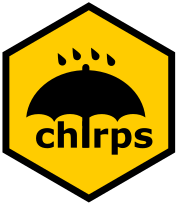Chirps
We often take it for granted that when a large database exists, there are API clients that make it easy to digest in our language of choice. These libraries empower awesome research, but hardly get noticed. This is the case for ropensci/chirps a library in R that gives you programmatic access to the entire Climate Hazards Group InfraRed Precipitation with Station Data “CHIRPS” database.

And so we are going to showcase this quiet, and valuable tool this week! We encourage you to contribute to the research software encyclopedia and annotate the respository:
or learn more about it in the following sections.
- What is Chirps?
- How do I cite it?
- How do I contribute to the software survey
- Where can I learn more?
What is chirps?
Chips gives us programmatic access in R to the entire Climate Hazards Group InfraRed Precipitation with Station Data “CHIRPS” database. This is no small thing - the database is over 35 years old! Directly from the database documentation:
Climate Hazards Group InfraRed Precipitation with Station data (CHIRPS) is a 35+ year quasi-global rainfall data set. Spanning 50°S-50°N (and all longitudes) and ranging from 1981 to near-present, CHIRPS incorporates our in-house climatology, CHPclim, 0.05° resolution satellite imagery, and in-situ station data to create gridded rainfall time series for trend analysis and seasonal drought monitoring.
If you are a scientist and interested in studying rainfall, or want to contribute to our understanding of climate change, this seems like an amazing resource. It’s even provided in the Google Earth Engine catalog. But of course if R is your cup of tea, this is the library for you!
How do I cite it?
Like this!
@ARTICLE{De_Sousa2020-px,
title = "chirps: {API} Client for the {CHIRPS} Precipitation Data in {R}",
author = "de Sousa, Kau{\^e} and Sparks, Adam and Ashmall, William and van
Etten, Jacob and Solberg, Svein",
abstract = "Software archive",
journal = "JOSS",
volume = 5,
number = 51,
pages = "2419",
month = jul,
year = 2020
}
And see this section of the documentation for more details on citation. Basically, along with the package, they recommend that you also cite CHIRPS proper:
@ARTICLE{Funk2015-rq,
title = "The climate hazards infrared precipitation with stations-a new
environmental record for monitoring extremes",
author = "Funk, Chris and Peterson, Pete and Landsfeld, Martin and
Pedreros, Diego and Verdin, James and Shukla, Shraddhanand and
Husak, Gregory and Rowland, James and Harrison, Laura and Hoell,
Andrew and Michaelsen, Joel",
abstract = "The Climate Hazards group Infrared Precipitation with Stations
(CHIRPS) dataset builds on previous approaches to 'smart'
interpolation techniques and high resolution, long period of
record precipitation estimates based on infrared Cold Cloud
Duration (CCD) observations. The algorithm i) is built around a
0.05° climatology that incorporates satellite information to
represent sparsely gauged locations, ii) incorporates daily,
pentadal, and monthly 1981-present 0.05° CCD-based precipitation
estimates, iii) blends station data to produce a preliminary
information product with a latency of about 2 days and a final
product with an average latency of about 3 weeks, and iv) uses a
novel blending procedure incorporating the spatial correlation
structure of CCD-estimates to assign interpolation weights. We
present the CHIRPS algorithm, global and regional validation
results, and show how CHIRPS can be used to quantify the
hydrologic impacts of decreasing precipitation and rising air
temperatures in the Greater Horn of Africa. Using the Variable
Infiltration Capacity model, we show that CHIRPS can support
effective hydrologic forecasts and trend analyses in southeastern
Ethiopia.",
journal = "Sci Data",
volume = 2,
pages = "150066",
month = dec,
year = 2015,
language = "en"
}
How do I get started?
If you want to get started with using Chirps, here are some good resources!
- An Introduction to Chirps with Brazilian Amazon data!
- JoSS Paper about Chirps
- Chirps Website
You can also post questions on the GitHub issues board.
How do I contribute to the software survey?
or read more about annotation here. You can clone the software repository to do bulk annotation, or annotation any repository in the software database, We want annotation to be fun, straight-forward, and easy, so we will be showcasing one repository to annotate per week. If you’d like to request annotation of a particular repository (or addition to the software database) please don’t hesitate to open an issue or even a pull request.
Where can I learn more?
You might find these other resources useful:
- The Research Software Database on GitHub
- RSEpedia Documentation
- Google Docs Manuscript you are invited to contribute to.
- Annotation Documentation for RSEpedia
- Annotation Tutorial in RSEng docs
For any resource, you are encouraged to give feedback and contribute!
Recent Posts
- Posted on 21 Mar 2021
- Posted on 07 Mar 2021
- Posted on 21 Feb 2021
- Posted on 21 Feb 2021